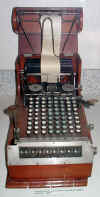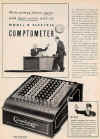|
| Antique Adding and Calculating Machines |
Key-Driven Calculating Machines

Serial Number 3234, made 1898
Dorr E. Felt (1862-1930) built the prototype of a key-driven calculating machine using a wooden macaroni box as a case in 1885. In 1887 he obtained a patent, co-founded the Felt & Tarrant Manufacturing Co., and sold the first few Comptometers. An Oct. 1888 article on the Comptometer stated that the "accuracy and durability of the machine have been thoroughly tested in the actuary's department of the United States Treasury at Washington, where one is in constant use." (Scientific American, Oct. 27, 1888) In total, about 700 Comptometers were manufactured by late 1891. A June 1892 ad stated that Comptometers were "Now in use in hundreds of Banks and Counting Rooms." [Insert image Office 9/88]
An April 1895 ad stated that Comptometers were "in use in over a thousand Counting Rooms, and in the offices of six Governments," and that "Over fifty have bought a second after buying a first." Assuming that every serial number was used, about 2300 Comptometers had been produced by late 1896. A December 1900 ad stated that Comptometer were "in hundreds of railroad and insurance offices" and "used by accountants and engineers in all lines of business." The ad also stated that "in the US Navy Department over 85 Comptometers are used in engineering computations" and "nearly one thousand manufacturing and commercial firms after buying one Comptometer have ordered a second one, and scores have purchased and used in their accounting rooms from 10 to 25 each."
Comptometers with wood cases were produced for about 16.5 years, from mid or late 1887 through 1903, after which cases were made of metal. The total number of wood-cased units manufactured did not exceed about 6300. Average annual production of wood-cased Comptometers increased from about 155 during the first 4.5 years (mid 1887-1891), to (at most) about 320 during the next five years (1892-96), and then to about 570 during the final seven years (1897-1903).
A 1908 ad claimed that Marshall Field & Co. used 395 Comptometers. According to Boering, cumulative Comptometer sales were approximately 6,300 units by 1903; 15,650 by 1909; 77,650 by 1920; and 126,150 by 1926. See also Kidwell (2001, p. 10). In 1897, wood-cased Comptometers were $125-$400, depending on the number of columns, which ranged from 8 to 16. In 1903, one wood-cased Comptometer model was $125. In 1904, a metal-cased Model A was $125. In 1906, different models were $125-$200. In 1907, one model was $150 and a Model B was $200-$315. In 1924, a Model H was $300-$400.
Comptometers operated substantially faster than adding-listing machines, because they did not have printers. According to a 1906 report, the Comptometer "is undoubtedly the most rapid machine in operation in the world, either for addition or for multiplication of small amounts, not to exceed nine figures in the quotient." (The Business Man's Magazine, Aug. 1906, p. 63)
The Comptograph, a key-driven calculator like the Comptometer but with a printer, was patented by Felt in 1889. In 1916, the manufacturer stated that Comptographs were marketed as early as 1891. In fact, a product review introducing the Comptogragh appears in The Office, May 1891, p. vii. This review states that "The Comptograph was primarily designed for listing and adding checks in a bank." It also states that "The Compotograph will only add a sum as it is listed. It is not adapted to multiplying, dividing or computing interest like the Comptometer. It simply prints a list or column of items, at the same time adding them and printing the answer beneath. At any time during the operation the machine shows through the glass plate the amount of all checks added up to that point, and the subfooting can be put in a column of figures at any point, by simply pressing the answer knob." Around 1900, Comptographs were $350 and up. (Kidwell 2001, p. 11) Felt & Tarrant produced the Comptograph until 1902, when the company was divided. After the spin-off, Felt & Tarrant continued to produce the Comptometer while the Comptograph Co. produced the Comptograph. During 1907-11, the company marketed Model 2A, which was $375. In 1908, Comptographs were offered with electric motor drives. Production of the Comptograph is reported in secondary sources to have ceased around 1920, but we have seen no evidence of Comptographs marketed after 1914. According to a 1906 report, Comptographs were practically unknown to the general public, and it was rare to see them in either banks or business houses. (The Business Man's Magazine, Aug. 1906, p. 62) Apparently, a large share of Comptograph's sales were in Europe.
A description of the Comptometer explains that "Multiplication is merely a rapid process of addition. Assuming it is desired to multiply 158 by 49: put one's fingers over 1 on the hundreds column, 5 in the tens column, and 8 in the units column. By using both hands this could easily be done with one operation. These three fingers should be simultaneously depressed nine times, and the result is that we have multiplied 158 by 9. Then, without disturbing the relative positions of the fingers, shift them one place to the left, and depress them four times, the effect of which is to multiply 158 by 40. It is easily demonstrated that in the matter of multiplication the Comptometer is 8 to 10 times as fast as the human calculator operating with pencil and paper." (Lawrence R. Dicksee, Office Machinery and Appliances, London, 1916-18, pp. 54-55)
Subtraction is carried out by complementary addition: On each key, in addition to the number that is used for purposes of addition and multiplication, there is a second number in a smaller font. The sum of the two numbers on each key is 9. Thus, for example, the 6 key has the number 3 in a smaller font. "If we take the Comptometer with the register set at zero, and press the key 7, the figure 7 shows in the register. If we want to subtract 7 (thus reducing the register again to zero) we work from the small figures of the keys, choosing the key with a small figure one below the number we desire to subtract. Accordingly, in this case, we select the key with the small figure 6, i.e., the key with the large figure 3. Depressing this key, when we already have 7 on the register, would cause the register to show 10; but, by slightly pushing forward with the finger or thumb of the left hand a little projecting lever, we prevent the machine from carrying, so that, while the units column is altered to zero, there is no 1 carried forward to the tens column." (Id., pp. 55-56)
Felt & Tarrant Key-Driven Calculating Machines
Other Early Key-Driven Calculating Machines













